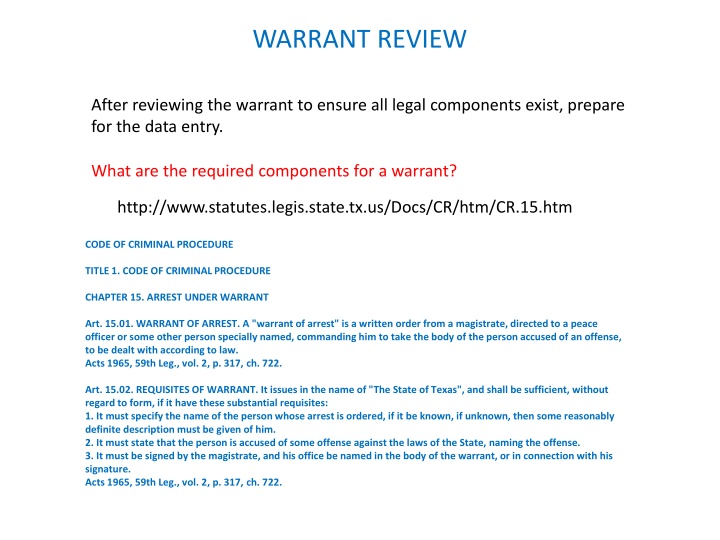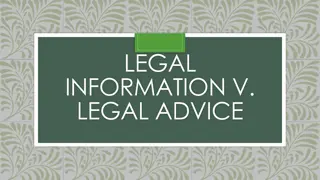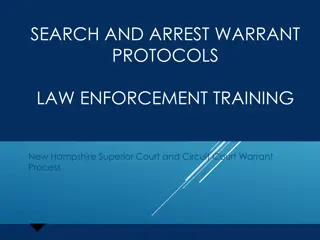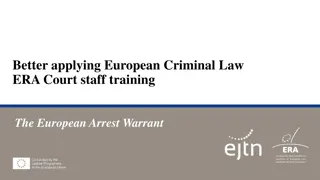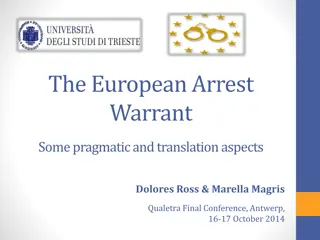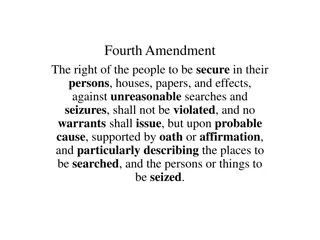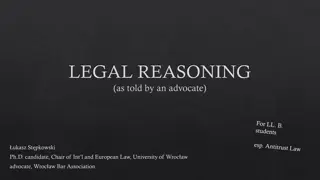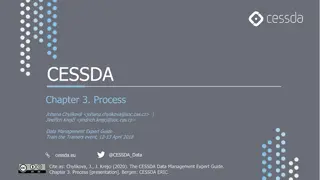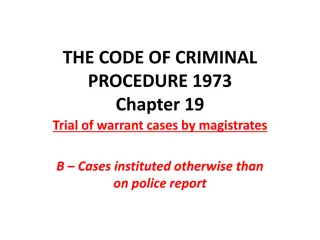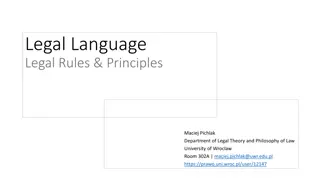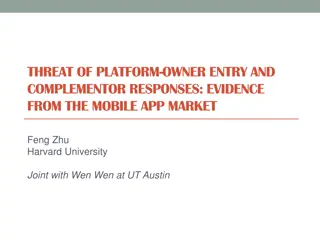Essential Components of a Warrant: Legal Requirements and Data Entry Process
In preparing for data entry after reviewing a warrant, ensure the necessary components are in place. These components include the name of the accused, details of the offense, signature of the magistrate, and more as specified under the Texas Code of Criminal Procedure. The process also involves querying databases for driver's license information, checking criminal history records, and entering relevant details into the TCIC/NCIC system.
Download Presentation

Please find below an Image/Link to download the presentation.
The content on the website is provided AS IS for your information and personal use only. It may not be sold, licensed, or shared on other websites without obtaining consent from the author.If you encounter any issues during the download, it is possible that the publisher has removed the file from their server.
You are allowed to download the files provided on this website for personal or commercial use, subject to the condition that they are used lawfully. All files are the property of their respective owners.
The content on the website is provided AS IS for your information and personal use only. It may not be sold, licensed, or shared on other websites without obtaining consent from the author.
E N D
Presentation Transcript
WARRANT REVIEW After reviewing the warrant to ensure all legal components exist, prepare for the data entry. What are the required components for a warrant? http://www.statutes.legis.state.tx.us/Docs/CR/htm/CR.15.htm CODE OF CRIMINAL PROCEDURE TITLE 1. CODE OF CRIMINAL PROCEDURE CHAPTER 15. ARREST UNDER WARRANT Art. 15.01. WARRANT OF ARREST. A "warrant of arrest" is a written order from a magistrate, directed to a peace officer or some other person specially named, commanding him to take the body of the person accused of an offense, to be dealt with according to law. Acts 1965, 59th Leg., vol. 2, p. 317, ch. 722. Art. 15.02. REQUISITES OF WARRANT. It issues in the name of "The State of Texas", and shall be sufficient, without regard to form, if it have these substantial requisites: 1. It must specify the name of the person whose arrest is ordered, if it be known, if unknown, then some reasonably definite description must be given of him. 2. It must state that the person is accused of some offense against the laws of the State, naming the offense. 3. It must be signed by the magistrate, and his office be named in the body of the warrant, or in connection with his signature. Acts 1965, 59th Leg., vol. 2, p. 317, ch. 722.
PREPARING FOR ENTRY Query the state Driver License database and print the applicable results.
PREPARING FOR ENTRY Query the State and Federal Criminal History systems to determine if the person has been arrested/detained previously. Print the Criminal History Records applicable to the subject named in the warrant.
PREPARING FOR ENTRY Query TCIC/NCIC (ZW or QW) to see if your agency has an existing record for the subject. If one is found, you may need to update/modify the ADO field of the existing record. Otherwise, your work for TCIC/NCIC on the new warrant is done.
TCIC/NCIC WARRANT ENTRY The below fields are specific to the agency, and to the warrant itself. Some warrants will have the CJIS Offense Code (8 digits) on them. The first four (4) characters are typically the NCIC Offense Code used for warrant entry. For those that do not, to determine the NCIC Offense Code reference the NCIC Code Manual or the on-line CJIS Offense list found at http://www.dps.texas.gov/administration/crime_records/pages/appndxKOffenseCodes.htm The Date of Warrant/Violation is the date the warrant was signed by the court representative.
TCIC/NCIC WARRANT ENTRY Bond forfeiture warrants will have an offense code of 5001. The offense code for the original warrant associated with the case will be keyed into the Original Offense Code (OOC) field. Example: Bond Forfeiture warrant for previous case of DWI would be coded as 5001/ 5404. Warrants to revoke personal bond will have an offense code of 5002. The offense code for the original warrant associated with the case will be keyed into the Original Offense Code (OOC) field. Example: Personal Bond Revocation warrant for previous case of DWI would be coded as 5002/ 5404. Probation Violation warrants will have an offense code of 5012. The offense code for the original warrant associated with the case will be keyed into the Original Offense Code (OOC) field. Example: Probation Violation warrant for previous case of DWI would be coded as 5012/ 5404.
TCIC/NCIC WARRANT ENTRY The below fields are specific to the agency, and to the warrant itself. The Originating Case Number (OCA) can be the warrant cause number. Some agencies, however, have a sequential numbering system internally for the OCA and insert the warrant cause number in the Warrant Number (WNO) field. Additional Offense (ADO) is used to indicate if your agency holds more than one warrant for the person.
TCIC/NCIC WARRANT ENTRY Notify Originating Agency (NOA) will be marked as Y if your agency wishes to be notified any time another agency s query hits your record. Linkage Agency ORI (LKI) and Linkage Case Number (LKI) are used to tie two different record entries together. Typically this is used for multi- jurisdictional cases. (LKA becomes available when LKI is entered.)
TCIC/NCIC WARRANT ENTRY Extradition Limitation (EXL). Your agency must determine prior to the record entry how far you will go to pick up the subject of the warrant. NOTE: TCIC and NCIC now allow for xx miles but that specific distance must be stated in the MIS field. (Code 4 and D)
TCIC/NCIC WARRANT ENTRY The below fields are specific to the subject of the warrant (AKA Defendant). In accordance with Texas CCP, Article 15, the defendant/subject s name must be shown on the warrant. Use the name shown on the warrant to enter data into the Name (NAM) field. Typically the person s DOB is also shown on the warrant itself. Use the DOB shown on the warrant in your TCIC/NCIC primary DOB field. Additional names and DOBs will be entered later as supplemental data.
TCIC/NCIC WARRANT ENTRY If the warrant provides other demographic details, or numbers related to the subject/defendant, enter those into the appropriate fields of your primary record screen. If the warrant does not other demographic details, or numbers related to the subject/defendant, refer to the Driver License and Criminal History responses you received (if any) and enter data into the appropriate fields of your primary record screen.
TCIC/NCIC WARRANT ENTRY If a conflict is found between the race shown on the warrant, the criminal history record(s) and driver license response, enter the race as U . Note: Where the DL system appears to state the race is HISPANIC , use either the race code from the CCH/III or enter U. Hispanic is an ethnicity, not a race. You may enter the ethnicity in all person records.
TCIC/NCIC WARRANT ENTRY The Place of Birth (POB) and Citizenship (CTZ) data will be derived from the Criminal History responses. If Texas CCH conflicts with NCIC III data, pick one using your best judgement. Example: If Texas CCH reads TE/US, and III reads TX/US, you will enter TX/US because there is not a state of the USA with the abbreviation (code) of TE. (TE= Spratly Islands in the South China Sea)
TCIC/NCIC WARRANT ENTRY Scars Marks and Tattoos (SMT) data will potentially found on the Criminal History responses or from your own agency s previous booking information. For data listed in the TX or III responses, you will enter one on the initial warrant screen. Others will be entered later during supplemental data entry.
TCIC/NCIC WARRANT ENTRY Warrants may have the Social Security Number (SOC). If not, and a Criminal History record was found for the subject, enter the number from that source. Your agency may have this type of information in other sources such as booking data. If more than one SOC is found, additional numbers will be entered later during supplemental data entry. Only enter information that is true and correct for the subject of your warrant. Example: The Social Security Administration will not issue a SOC of 111-11-1111.
TCIC/NCIC WARRANT ENTRY Warrants may have the criminal SID# listed. If not, a Criminal History record may be found for the subject. In either case, enter the number in the State ID# field.
TCIC/NCIC WARRANT ENTRY Warrants may have the Personal ID number. If not, and a Criminal History record was found for the subject, enter the number from that source in the Miscellaneous Number (MNU) field as PI-nnnnnnnn, then add specific information to the MIS field similar to MNU/PI=Texas Issued Personal ID (or whatever state issued it). State Issued Personal ID information can also be found via Driver License queries. Only enter information that is true and correct for the subject of your warrant. NOTE: For a while, Texas DPS re-issued driver license and personal ID numbers.
TCIC/NCIC WARRANT ENTRY Alien Registration and Military ID numbers are also entered into the MNU field. Data such as this will typically be found on the NCIC III criminal history response. Texas CCH may contain numbers for licensed individuals within the state. Those are not eligible for entry into the TCIC/NCIC databases since you cannot query CCH using those numbers.
TCIC/NCIC WARRANT ENTRY Alien Registration and Military ID numbers are also entered into the MNU field. Data such as this will typically be found on the NCIC III criminal history response. Where there are multiple MNU data elements identified during the preparatory research, your agency should have a policy stating which to enter into the TCIC/NCIC base record. Example: Travis County SO- if there is a MNU/PI and a MNU/OA, enter the MNU/PI in the base record, and the MNU/OA in the supplemental data. Texas CCH may contain numbers for licensed individuals within the state that require a criminal history background check. Those are not eligible for entry into the TCIC/NCIC databases since you cannot query CCH using those numbers.
TCIC/NCIC WARRANT ENTRY FBI Number/UCN (FBI). Enter the FBI number reflected on the NCIC III Criminal History record response, if such a record is found. Where the Texas CCH and FBI responses do not reflect the other entity s number, send an email to error.resolution@dps.texas.gov asking for review for potential synchronization of the two databases. Examples: Texas CCH does not have an FBI number. NCIC III full rap sheet shows a Texas arrest, but does not list the Texas SID.
TCIC/NCIC WARRANT ENTRY Fingerprint Classification (FPC). Enter the data found on the criminal history response in the field named also FPC. There will be 20 characters- 2 for each finger. If FPC data exists within both the Texas CCH and NCIC III, your agency should have a policy stating which to enter into the warrant record. Example: Travis County SO uses the NCIC III FPC data. If there is no NCIC III FPC data, and there is FPC data in Texas CCH, enter the data from Texas CCH.
TCIC/NCIC WARRANT ENTRY Some warrants list the defendant/subject s driver license number. After verification through a DL inquiry, enter the number into the OLN field. Only enter Driver License and Airplane Pilot License Numbers into this field. A state issued personal ID is entered, as discussed previously, into the MNU field as PI-nnnnnnn. Only enter information that is true and correct for the subject of your warrant. For a while, Texas DPS re-issued driver license and personal ID numbers.
TCIC/NCIC WARRANT ENTRY Once OLN data is entered in the screen, the State of Issuance (OLS) and Year of Expiration (OLY) become available. Enter information found within the DL query response. Texas DPS issues a DL Number or ID Number when a person begins the paperwork to request the form of identification. If the person does not successfully complete the process, there will be no year of expiration noted on the DL system response. It s not a good number for data entry of a TCIC/NCIC record because it is not valid!
TCIC/NCIC WARRANT ENTRY Some warrants contain address data. Where that is the case, or if your agency has address data stored in your local records, it should be entered into the TCIC/NCIC record. Address Type (ADD) will be a number to represent how the address is related to the defendant.
TCIC/NCIC WARRANT ENTRY Some warrants contain address data. Where that is the case, or if your agency has address data stored in your local records, it should be entered into the TCIC/NCIC record. Typically the data of documented address (DDA) will be the date the warrant was created, if the address data originated from the warrant. If your agency has address data from previous bookings, or probation offices, it may be entered. Caution should be exercised in entering the address shown on a DL system response. It is not stipulated on the TLETS return when the address data was last updated for the DL/ ID card.
TCIC/NCIC WARRANT ENTRY Some warrants contain vehicle information. Where that is the case, it should be entered into the TCIC/NCIC record. Caution should be exercised in entering vehicle data where the vehicle is not registered to the warrant subject.
TCIC/NCIC WARRANT ENTRY Per the NCIC Operating Manual, section 1.9 - CRITERIA FOR ENTERING NAMES AND DATES OF BIRTH FOR STOLEN/ FRAUDULENT IDENTIFIERS The general rule for the use of stolen/fraudulent (S/F) identifier fields is that they must be used whenever a wanted person is known to be using identification documents that are stolen/fraudulent. If the wanted person is using a made-up name or numerical identifier for which it is not known whether identification documents (Social Security card, operator's license, etc.) exist, these identifiers should be entered in the appropriate base record or supplemental identifier fields, such as the DOB Field. If the identity of the thief is known and there is an arrest warrant, the victim information should be entered in the S/F fields.
TCIC/NCIC WARRANT ENTRY Where Extradition is limited (defined in EXL field previously discussed), the MIS field must contain the specifics of where you are willing to travel to acquire the subject/defendant. Examples: EXL=Texas only; EXL=surrounding counties only; EXL=300 miles from Austin, Texas
TCIC/NCIC WARRANT ENTRY Where the full complete name does not fit into the name field, whether the name is the base record name or supplemental name, the entire complete name is to be entered in the MIS field. Example: Complete name = SUPERCALIFRAGILISTIC,MARY POPPINS Additional information may be entered into the MIS field that reflects the issuing court, bond amount, and/or bond conditions. There are a few gotchas : Do not enter HIV related information. Do not enter information that can be keyed into a specific field. Periods are prohibited. The MIS field is only 500 characters.
TCIC/NCIC WARRANT ENTRY Where multiple names, DOBs, numerical identifiers, and SMTs are found during the preparatory research, that exceed the number of those items that TCIC/NCIC will allow during supplemental record entry, the additional information is to be added within the MIS field. 99 Alias Names 9 Scars, Marks, Tattoos 9 Date of Birth 9 Owner License # 9 Miscellaneous # 9 Social Security # 10 Caution/Medical Conditions 9 License Plate Sets 9 Vehicle sets 9 Address sets 9 Citizenship 9 Image numbers
TCIC/NCIC WARRANT SUPPLEMENTAL DATA ENTRY The below fields are specific to the existing TCIC/NCIC record. Identify the record you are going to be adding information to. Use the NIC# and OCA, or Use the NIC# and the complete name as you typed it previously for the initial record entry, or Use the OCA and the complete name as you typed it previously for the initial record entry. Gotcha: If you like to copy/paste from the Message Window acknowledgment, do not use the NCIC acknowledgement. NCIC transforms all letter O characters into the number 0 character. TCIC will reject your supplemental data entry stating record not found because TCIC has the identifier with an O, not a 0 (zero). It does not matter if it s the OCA or the Name field. All letter Os are transformed by NCIC into 0 (zeros).
TCIC/NCIC WARRANT SUPPLEMENTAL DATA ENTRY The below fields are specific to the existing TCIC/NCIC record. Additional data can be found in the Criminal History records, Driver License Records, and local agency information sources. Key up to 9 total data elements in one screen.
TCIC/NCIC WARRANT SUPPLEMENTAL DATA ENTRY Follow the same principles previously discussed for the entry of address and/or vehicle supplemental data. Remember Only enter information that is true and correct for the subject of your warrant.
WHAT COMES NEXT? REVIEW YOUR WORK
TCIC/NCIC WARRANT DATA ENTRY FINESSE Compare the warrant to the TCIC/NCIC record. Check the TCIC/NCIC record to be sure it contains all appropriate/applicable data shown in TxCCH and NCIC III. Check the TCIC/NCIC record to be sure it contains all appropriate/applicable data shown in Driver License System responses.
TCIC/NCIC WARRANT DATA ENTRY FINESSE Modify base record if needed. Add additional information missed in the first round of supplemental data entry in the same manner described previously. (MKE:EN) Remove incorrect data (typos) using the XN transaction.
